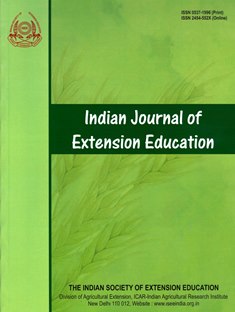Extent of Adoption of Intercropping Practices Among Farmers of Haryana
DOI:
https://doi.org/10.48165/IJEE.2023.59105Keywords:
Adoption, Intercropping, Haryana, Agriculture, Farmers, ReasonsAbstract
Intercropping is a variant of multiple cropping practices that includes the cultivation of two or more crops in definite close proximity. The current study was led in dry and wet agro climatic zones of Haryana in 2022 with an objective to assess the adoption of intercropping practices among farmers of Haryana. The primary data were collected personally from 120 respondents through a well-structured interview schedule. Findings revealed that nearly three-fifths of the respondents had medium level of adoption of intercropping practices and the farmers were adopting intercropping mainly in vegetables. Highly significant association was found between education, mass media exposure, inheritance with level of adoption of the intercropping system. A significant association was found between age, caste, annual income, land holding, extension contacts with level of adoption. The main reasons for adoption of intercropping were higher income and improved socio-economic status. The paper recommends on field training/demonstration for farmers who were adopting intercropping so that adoption of intercropping can be made efficient and from this more number of farmers will be encouraged to adopt intercropping.
Downloads
References
Dwivedi, A., Dev, I., Kumar, V., Yadav, R. S., Yadav, M., Gupta, D., & Tomar, S. S. (2015). Potential role of maize-legume intercropping systems to improve soil fertility status under smallholder farming systems for sustainable agriculture in India. International Journal of Life Sciences Biotechnology and Pharma Research, 4(3), 145-157.
Himmelstein, J., Ares, A., Gallagher, D., & Myers, J. (2017). A meta analysis of intercropping in Africa: impacts on crop yield, farmer income, and integrated pest management effects. International Journal of Agricultural Sustainability, 15, 1-10.
Islam, M. S. (2017). Adoption of intercropping with mango by the farmers of Bagha Upazila under Rajshahi district, Bangladesh. Ph.D., thesis, Sher e Bangla Agricultural University, Dhaka, Bangladesh. http://www.saulibrary.edu.bd/daatj/public/index.php/ getDownload/Done%2011-04577%20k_11.pdf
Jat, M. L., Jaiswal, D. K., & Saharawat, Y. (2021). Extent of knowledge and adoption of recommended wheat production practices among wheat growers in Malwa Region (M.P.). Indian Journal of Extension Education, 58(1), 40–43.
Kamboj, S. (2022). Intercropping is becoming the break of increase in cost price, Yamuna Nagar at number one. Jagran. Retrieved June 7, 2022 from https://www.jagran.com/haryana/yamunanagar intercropping-is-best-option-for-increase-the-income-of-farmar 21357402.html
Kaur, N., Bhullar, M. S., & Gill, G. (2015). Weed management options for sugarcane-vegetable intercropping systems in north western India. Crop Protection, 74, 18-23.
Kota, S., Naik, M. R., Reddy, R. U., & Thirupathi, I. (2021). Adoption of intercropping practices by the cotton farmers in Mancherial district of Telangana state. International Journal of Plant and Soil Science, 33(7), 46-52.
Kumari, V., Chander, S., & Sharma, S. (2021). Knowledge and adoption of drip irrigation in citrus crops among farmers of western Haryana. Indian Journal of Extension Education, 58(1), 151–156.
Laishram, C., Vashishat, R. K., Sharma, S., Rajkumari, B., Mishra, N., Barwal, P., & Sharma, N. (2022). Impact of natural farming cropping system on rural households-evidence from Solan District of Himachal Pradesh, India. Frontiers In Sustainable Food Systems, 6, 1-12
Maitra, S., Palai, J. B., Manasa, P., & Kumar, D. P. (2019). Potential of intercropping system in sustaining crop productivity. International Journal of Agriculture, Environment and Biotechnology, 12(1), 39-45.
Meena, M. L., Singh, D., & Chaudhary, M. K. (2011). Farmers’ perception on cumin based intercropping systems: a case in arid zone of Rajasthan. Indian Journal of Extension
Education, 47(3&4), 45-49.
Nagdanbhai, H. U. (2012). Knowledge and adoption of castor as intercrop with groundnut in south Saurashtra agro-climatic zone of Gujarat. M.Sc., Thesis, Junagadh Agricultural University, Junagadh. https://krishikosh.egranth.ac.in/handle/1/5810024098
Sharma, N. K., Singh, R. J., Mandal, D., Kumar, A., Alam, N. M., & Keesstra, S. (2017). Increasing farmer’s income and reducing soil erosion using intercropping in rainfed maize-wheat rotation of Himalaya, India. Agriculture, Ecosystems and Environment, 247, 43-53.
Singh, T., Kaur, M., & Singh, G. (2021). Extent of adoption of happy seeder technology among the farmers of Punjab (India). Indian Journal of Extension Education, 57(4), 75–79.
Downloads
Published
Issue
Section
License

This work is licensed under a Creative Commons Attribution-NonCommercial-NoDerivatives 4.0 International License.

